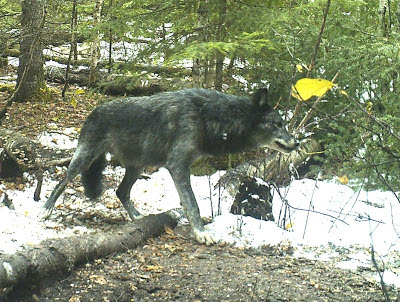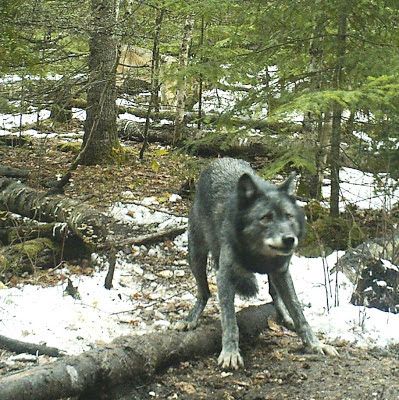 |
| Nadine Thibeau and Jim Castle implant a tracking device | |
|
|
Ontario Ministry of Natural Resources fish and wildlife personnel gathered more than 100 lake trout this fall to help regenerate Red Lake's once-burgeoning lake trout population.
Under the direction of new biologist Jim Castle, the MNR crews caught and gathered the eggs and milt from 50 female and 50 male trout. It was the best catch in many years possibly due to weather conditions. Autumn came early this year, plunging the lake temperature to the lake trouts' preferred 10-12 C for spawning. In other years the temperature has been too warm until late in October which is then too late for the trout to spawn,
This year marks a new strategy for the MNR trout project. In addition to producing about 150,000 fingerlings to be released back to Red Lake in 18 months, other fingerlings will be kept at the MNR hatchery in Dorion, Ont., and will be raised to become brood stock. Once those fish reach maturity in about seven years, their eggs and milt will be gathered for the Red Lake restocking program.
There have been several developments in the trout situation in Red Lake.
The first was the discovery by Castle that Red Lake's trout DNA shows there are four distinct groups of trout. Trout are genetically distinct in each lake that they are found. Castle had first guessed there might be two types in Red Lake: Pipestone Bay fish and those from the rest of the lake. He had reasoned that Pipestone was once a lake unto itself and only became part of Red Lake when the Snowshoe Dam was built in 1948. That raised the water level about four feet. The present tiny entrance to Pipestone Bay is only about five feet deep. It is likely that before the dam was created Pipestone was joined to the rest of the lake by either a small creek or even a rapids. Pipestone, was in effect, a lake, not a bay.
 |
| Kyle Pace brings a large trout to shore for spawning |
Castle sent away samples of fish that the MNR has gathered over the years and found to his surprise that there were four different strains of trout in Red Lake. Possibly some of the trout came from introductions in the past although there is no record of this.
At any rate, his hypothesis was that since the MNR in the past had been gathering all of the trout for the restocking project in Pipestone Bay, it was logical then that stocked fish would return to Pipestone to spawn. That is something the MNR team doesn't want to happen because studies show that lake trout eggs usually do not survive in Pipestone Bay. The reason is still a mystery and making the situation all the more enigmatic is the observation that once in awhile, they do survive.
This year the MNR gathered spawning fish from three areas instead of just Pipestone. They were Potato Island basin, Trout Bay and Pipestone Bay. The Pipestone and non-Pipestone fish were kept separate and were mated with those from their own area. The researchers also implanted tracking devices in about 20 trout and will monitor their movements around the lake.
Here at Bow Narrows Camp we are in a perfect position to have witnessed the entire lake trout saga.
Back in the 1960s and 70s, we had good lake trout fishing at the west end of the lake where the camp is located. By and large our guests made up the majority of people who fished for trout. In a day's fishing you might catch 6-12 fish and they varied in size from one pound to 25 pounds.
Then, in the 1980s, the lake trout population seemed to go berserk. Our fishermen might catch 20 fish in a day and they were all huge, 16 pounds up to as large as 40 pounds. At this time Red Lake's trout fishing was ranked among the best in the world, as good as places like Great Bear Lake in the Northwest Territories.
About the same time smelt were discovered in Red Lake. Smelt are native only to the Pacific Ocean and were transplanted to the Great Lakes. It is likely that Red Lake residents who had gone "smelting" in Lake Superior unintentionally released fertilized smelt eggs into Red Lake. The same thing happened in just about every lake with road access in Northwestern Ontario.
Smelt are a highly nutritious fish and larger fish that eat them, such as lake trout, grow rapidly.
I believe that the introduction of smelt is what actually caused the eventual demise of lake trout in Red Lake.
Here's what I think happened: lake trout ate the blossoming smelt population and double or tripled their normal annual weight gain. When news of the tremendous trout fishing at the west end of the lake got out, anglers came from far and wide to catch them.
When Brenda and I returned to the camp business in 1992 (we had left to pursue other careers in 1978), I was stunned at the fishing pressure being placed on lake trout.
Now, instead of just Bow Narrows fishermen catching trout, there were also anglers from Black Bear Lodge, located about five miles to our east, many Red Lake residents who also winter-fished, all the camps at the east end of the lake, all of the camps on Gullrock Lake and even camps on Eagle Lake, more than 100 miles to our south!
Tiny locations such as Potato Island might have as many as two dozen boats fishing around them, almost around the clock.
The sustainable harvest of lake trout, as determined by MNR fish studies elsewhere, is one-half pound of fish per surface acre of water. I estimate that the entire year's harvest of trout by all the combined fishermen occurred in just a few days. Almost all of these boats were taking lots of fish in the 16-20 pound range every day. When you consider that each 20-pound fish accounts for the allowable yield of 40 acres, it doesn't take long before you have over-harvested the species. And this colossal overharvest went on day after day for more than a decade.
Lake trout are not a wary fish. This has been shown by an on-going MNR study on Squeers Lake, between Thunder Bay and Atikokan. Only ice fishermen are allowed to fish there and only through a lottery-type system on a couple of weekends. It's a small lake and easier for the fish researchers to watch the population. A few years ago the study purposely let fishermen overharvest the lake with the idea that the biologists would monitor how the population would respond. Surprisingly, the study also showed that even though there were fewer and fewer fish in the lake, the success rate of the fishermen didn't change. In other words, trout are eager to bite and it is plumb easy to catch every one of them.
That is what I think happened in Red Lake. In the space of just a decade or so, fishermen caught almost every trout, especially in the most heavily fished areas such as Potato Island. All the fish were big, were the spawners, and people just caught them all.
What about Pipestone Bay then? Pipestone is the farthest for all but Bow Narrows fishermen to reach. It didn't quite get the pressure. So more of its fish escaped. And in the end, those were almost the only fish left.
Why can't they spawn there today?
We don't know, except that there seems to be some naturally occurring blend of elements in the sediment that prevents their success. We also know that once in awhile, for reasons we still can't fathom, the eggs do survive. It might be a combination of temperature, wind conditions and water level.
Whatever, MNR studies have shown that the eggs do sometimes make it.
I suspect that has always been the situation. As long as there aren't hordes of anglers whipping them out of the lake, Pipestone is still able to sustain itself.
All lake trout fishing has been catch-and-release only now for about 10 years. Are there small lake trout being caught? A few and so far, none has been the stocked fish put back in the lake by the MNR.
Biologist Castle had some facts about smelt that might account for this.
First, smelt are voracious predators. They eat other fish when these species are still in the larval stages.
Smelt are also a mid-to-deep-depth species. They exist in the same water with lake trout. So, it is entirely possible that smelt are eating most of the larval-sized lake trout.
What about all the trout that have been released? It's true, they are too big for smelt to eat. There have been hundreds of thousands of them put back in the lake. Here's my theory: when the lake trout were removed from the deeper depths, the void was filled by walleye. Studies and our anglers' experience prove there are now lots of walleye in the deep depths. Walleye have been eating the trout fingerlings.
Walleye are unaffected by smelt predation because walleye in the larval stage, when they are vulnerable to smelt, exist in shallow water.
Castle calls such a situation a "predator pit." Trout can't get a start again because there are just too many predators (walleyes and smelt) down there. His plan is to overwhelm the predators. If he can release enough fingerling trout at one time, some of them will survive, and when they do, they will once again become the top predator. Walleye will be forced to stick to the safety of the shallows.
And with catch-and-release fishing, trout numbers should grow to the point where they will also overwhelm the smelt. This will let natural deep-water species such as whitefish, ling and tulibee to rebuild their populations too.
I think we are on the right track here.




















































